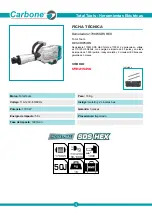
14
11.2
Positioning ram
11.2.1
Sliding ram fore and aft
Care should be taken to lock
ram securely after setting.
1. Loosen two handles (A, Figure 12) that lock
ram to its ways.
Figure 12: Ram positioning
2. Turn handle (B, Figure 12) to move ram on its
ways.
3. When desired position is reached, tighten
handles (A) securely.
Note: It is recommended while performing heavy
milling work, that the head be left as close to the
face of turret as possible. Maximum rigidity is then
obtained.
11.2.2
Rotating ram on its turret
Make sure machine base is
secured to floor before repositioning ram. The
center of gravity can shift enough to cause
machine to tip over, resulting in serious injury
to operator and damage to machine.
1. Loosen four turret lock bolts (C, Figure 12).
One-half (1/2) turn should be sufficient to allow
turret to move.
Note:
Use gentle hand
pressure to avoid rapid movement.
2. Turn ram until spindle is in desired position.
Use scale on turret to establish turn degree.
3. Tighten four turret lock bolts (C. Figure 12).
11.3
Gib adjustment
The table, saddle and knee are equipped with
adjustable gibs. The gibs may require adjustment if
unusual vibration is noted when locking
mechanisms are off, or if you experience unusual
vibration when spindle speed, tooth pitch or depth
of cut do not account for the vibration.
NOTE: When adjusting gibs, always start with the
knee first; adjust the saddle second, and adjust the
table last.
11.3.1
Knee gib
Loosen the two knee locking handles. The knee
gib adjustment screw (A, Figure 13) is located
under the chip wiper at rear of knee where it
contacts the column. Remove way cover and wiper
to expose gib adjustment screw. Tighten screw
until slight drag is felt when turning knee crank.
11.3.2
Saddle gib
Loosen saddle locking handle. The saddle gib
adjustment screw is on the left front of saddle (B,
Figure 13). Tighten screw until slight drag is felt
when turning cross-feed crank.
11.3.3
Table gib
Loosen table locking handles. The table gib
adjustment screw (C, Figure 13) is on the left-hand
side, beneath table. Tighten screw until slight drag
is felt when turning longitudinal table cranks.
Figure 13: Gib locations
11.4
Ram wear plate adjustment
1. Loosen two hex nuts and adjust the two set
screws as needed (#19,19-1, sect. 13.4.1).
2. Use a dial indicator to measure the amount of
movement in the ram. Adjust the wear plate
(#10, sect. 13.4.1) until the indicator reading is
within 0.003”.
3. Retighten hex nuts.
11.5
Table lead screw backlash
adjustment
Refer to Figure 14.
The milling machine table is moved by a lead
screw and nut for each machine axis. For proper
operation, there must be clearance between lead
screw and nut, which results in backlash. A second
feed screw nut is provided to eliminate most of the
backlash. The following procedures provide
instructions for obtaining acceptable backlash.
Summary of Contents for JVM-836
Page 7: ...7 6 0 JVM 836 Installation Layout Figure 1...
Page 17: ...17 13 1 1 JVM 836 Head Assembly Exploded View...
Page 20: ...20 13 2 1 JVM 836 Upper Head Assembly Exploded View...
Page 23: ...23 13 3 1 JVM 836 Leadscrew Assembly Exploded View...
Page 25: ...25 13 4 1 JVM 836 Base Assembly Exploded View...
Page 29: ...29 14 0 Electrical Connections for JVM 836...
Page 30: ...30 This page intentionally left blank...
Page 31: ...31 This page intentionally left blank...
Page 32: ...32 427 New Sanford Road LaVergne Tennessee 37086 Phone 800 274 6848 www jettools com...















































